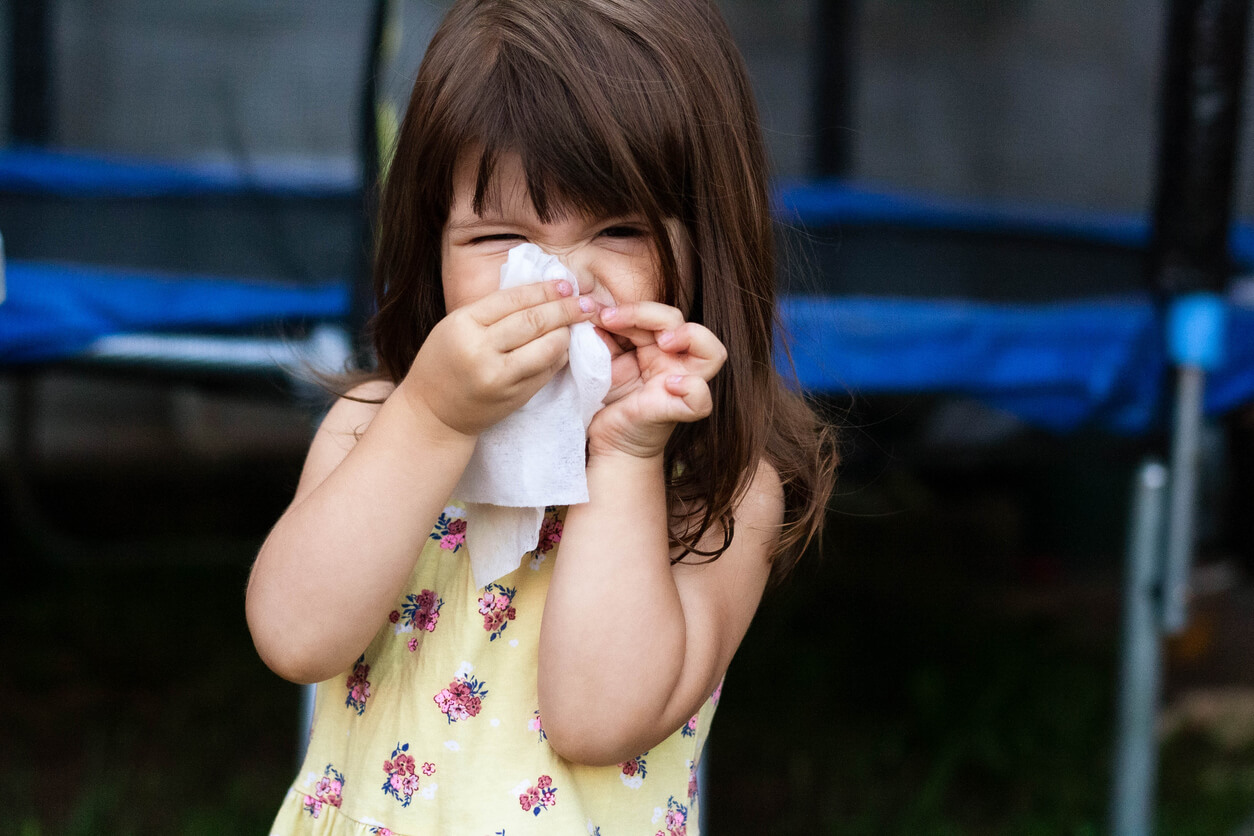Tuberculosis in Children: Symptoms, Causes, and Treatment


Written and verified by the doctor Diego Pereira
Tuberculosis is a disease that we often associated with adults, but did you know that tuberculosis in children also exists? Although the disease isn’t as prevalent in children as in adults, this doesn’t diminish its importance. In fact, children are also susceptible to developing complications, hence the need for early diagnosis. In the following article, you’ll find fundamental information to understand tuberculosis from its most basic aspects. Let’s go deeper.
What is tuberculosis?
According to a Mayo Clinic publication, tuberculosis is a potentially serious disease that usually affects the lungs and causes a chronic infection. In this case, it’s referred to as pulmonary tuberculosis, to differentiate it from another group called extrapulmonary tuberculosis, with manifestations in a wide variety of organs.
It’s primarily caused by infection with Mycobacterium tuberculosis, which is a type of bacteria. In certain contexts, infection by other similar microorganisms, such as M. bovis or M. microti, can also cause the disease.
Tuberculosis in children has been known for centuries. It has a rather particular historical context due to the high mortality it produced in overcrowded places with poor socio-sanitary conditions. At that time, it was popularly known as phthisis, a term that’s still used today in some contexts.
Find out more: Distinguish Bacterial from Viral Infections in Children

Symptoms
The symptoms of pulmonary tuberculosis are progressive in onset and tend to worsen over time. For this reason, affected individuals usually consult a physician when these clinical manifestations are bothersome or an associated complication occurs. In the case of children, the course may be atypical, which makes diagnosis difficult.
According to the website Healthy Children when a child suffers from tuberculosis disease, they may present the following symptoms:
- Fever
- Persistent cough
- Fatigue
- Irritability
- Changes in the respiratory pattern
- Enlarged lymph nodes
- Developmental or growth problems
On the other hand, there are rare occasions in which the causal microorganism can spread throughout the rest of the body and affect any organ or system. Extrapulmonary tuberculosis represents a serious health problem due to therapeutic difficulties. In addition, children living with some type of immunosuppression are more susceptible to this condition.
Causes
Tuberculosis in children is transmitted through the airborne route. When an infected person coughs, sneezes, or speaks very loudly, small particles of saliva containing the pathogenic microorganism are released into the air. They circulate in the air for a certain period of time, which depends on the existing conditions. Therefore, if a healthy person inhales them, they’re likely to develop the infection in the future.
Despite the ease of transmission, being a chronic disease, the incubation period is quite long. It can even last for years. In fact, there are children who never show symptoms. On the other hand, there are some factors that can increase the risk of infection in both children and adults:
- Living in overcrowded conditions
- Having a chronic disease without medical control, such as infection by the human immunodeficiency virus (HIV)
Discover more: Respiratory Physiotherapy in Pediatric Patients

Treatment
Fortunately, advances in scientific research have led to the development of effective drugs for the treatment of tuberculosis. As it’s a bacterial infection, these belong to the group of antibiotics. The most commonly used in children are isoniazid, rifampicin, and pyrazinamide.
According to a publication in the journal Pediatría Integral, there are other drugs that can help fight the disease under particular conditions. For example, steroids. However, these should be evaluated with caution by the medical team.
As with adults, there’s often difficulty in adherence to treatment. This is due to the fact that the usual therapeutic regimens can be prolonged for about 6 months and cause clinical improvement long before the end of the process. This causes many people to stop treatment because they “feel better” and think that everything has been solved. However, the latter practice is often associated with greater therapeutic failures in the long term.
In case of doubt, it’s better to go to a specialist
Tuberculosis in children is a complex disease that’s still considered a public health problem today. It occurs especially in some developing countries. This is due to the fact that socioeconomic conditions aren’t entirely suitable and access to health services may be limited.
If your child has been in contact with a person with tuberculosis or if they present symptoms compatible with the disease, it’s advisable to consult a pediatrician. The pediatrician will indicate all the diagnostic studies they consider pertinent for the patient.
Tuberculosis is a disease that we often associated with adults, but did you know that tuberculosis in children also exists? Although the disease isn’t as prevalent in children as in adults, this doesn’t diminish its importance. In fact, children are also susceptible to developing complications, hence the need for early diagnosis. In the following article, you’ll find fundamental information to understand tuberculosis from its most basic aspects. Let’s go deeper.
What is tuberculosis?
According to a Mayo Clinic publication, tuberculosis is a potentially serious disease that usually affects the lungs and causes a chronic infection. In this case, it’s referred to as pulmonary tuberculosis, to differentiate it from another group called extrapulmonary tuberculosis, with manifestations in a wide variety of organs.
It’s primarily caused by infection with Mycobacterium tuberculosis, which is a type of bacteria. In certain contexts, infection by other similar microorganisms, such as M. bovis or M. microti, can also cause the disease.
Tuberculosis in children has been known for centuries. It has a rather particular historical context due to the high mortality it produced in overcrowded places with poor socio-sanitary conditions. At that time, it was popularly known as phthisis, a term that’s still used today in some contexts.
Find out more: Distinguish Bacterial from Viral Infections in Children

Symptoms
The symptoms of pulmonary tuberculosis are progressive in onset and tend to worsen over time. For this reason, affected individuals usually consult a physician when these clinical manifestations are bothersome or an associated complication occurs. In the case of children, the course may be atypical, which makes diagnosis difficult.
According to the website Healthy Children when a child suffers from tuberculosis disease, they may present the following symptoms:
- Fever
- Persistent cough
- Fatigue
- Irritability
- Changes in the respiratory pattern
- Enlarged lymph nodes
- Developmental or growth problems
On the other hand, there are rare occasions in which the causal microorganism can spread throughout the rest of the body and affect any organ or system. Extrapulmonary tuberculosis represents a serious health problem due to therapeutic difficulties. In addition, children living with some type of immunosuppression are more susceptible to this condition.
Causes
Tuberculosis in children is transmitted through the airborne route. When an infected person coughs, sneezes, or speaks very loudly, small particles of saliva containing the pathogenic microorganism are released into the air. They circulate in the air for a certain period of time, which depends on the existing conditions. Therefore, if a healthy person inhales them, they’re likely to develop the infection in the future.
Despite the ease of transmission, being a chronic disease, the incubation period is quite long. It can even last for years. In fact, there are children who never show symptoms. On the other hand, there are some factors that can increase the risk of infection in both children and adults:
- Living in overcrowded conditions
- Having a chronic disease without medical control, such as infection by the human immunodeficiency virus (HIV)
Discover more: Respiratory Physiotherapy in Pediatric Patients

Treatment
Fortunately, advances in scientific research have led to the development of effective drugs for the treatment of tuberculosis. As it’s a bacterial infection, these belong to the group of antibiotics. The most commonly used in children are isoniazid, rifampicin, and pyrazinamide.
According to a publication in the journal Pediatría Integral, there are other drugs that can help fight the disease under particular conditions. For example, steroids. However, these should be evaluated with caution by the medical team.
As with adults, there’s often difficulty in adherence to treatment. This is due to the fact that the usual therapeutic regimens can be prolonged for about 6 months and cause clinical improvement long before the end of the process. This causes many people to stop treatment because they “feel better” and think that everything has been solved. However, the latter practice is often associated with greater therapeutic failures in the long term.
In case of doubt, it’s better to go to a specialist
Tuberculosis in children is a complex disease that’s still considered a public health problem today. It occurs especially in some developing countries. This is due to the fact that socioeconomic conditions aren’t entirely suitable and access to health services may be limited.
If your child has been in contact with a person with tuberculosis or if they present symptoms compatible with the disease, it’s advisable to consult a pediatrician. The pediatrician will indicate all the diagnostic studies they consider pertinent for the patient.
All cited sources were thoroughly reviewed by our team to ensure their quality, reliability, currency, and validity. The bibliography of this article was considered reliable and of academic or scientific accuracy.
- Méndez A, et al. Tuberculosis pulmonar. Pediatr Integral 2016;XX(2):109-118. Disponible en: https://www.pediatriaintegral.es/publicacion-2016-03/tuberculosis-pulmonar/.
- Healthy Children. La tuberculosis en los niños. Disponible en: https://www.healthychildren.org/Spanish/health-issues/conditions/chest-lungs/Paginas/tuberculosis.aspx.
- Clínica Mayo. Tuberculosis. Disponible en: https://www.mayoclinic.org/es-es/diseases-conditions/tuberculosis/symptoms-causes/syc-20351250.
This text is provided for informational purposes only and does not replace consultation with a professional. If in doubt, consult your specialist.








